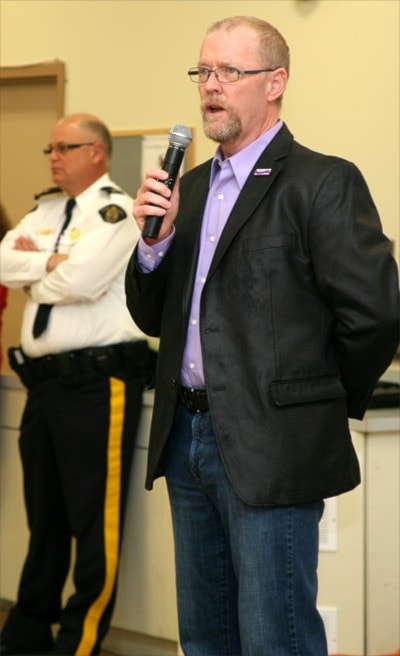Roughly 300 women find themselves at a shelter after trying to flee abuse in their homes each year in the Comox Valley.And a new public awareness campaign that officially kicked off this week is hoping to show people that number doesn't have to be so high.The Comox Valley Purple Ribbon Campaign raises awareness about violence in the broad sense — the nature of power and control over someone, including physical, emotional and verbal abuse - and encourages people to take a stand against violence. The theme of the campaign is Peace Begins at Home.The Comox Valley Transition Society (CVTS) sees between 260 and 300 women a year at Lilli House, its 24-hour shelter for women who are fleeing violence and their children, explained executive director Heather Ney.The CVTS also sees about 300 women a year for counselling and about the same number of children who have witnessed abuse and need counselling, noted Ney.According to the Comox Valley RCMP's domestic violence statistics, there were 209 spousal/partner dispute files in 2010 in which there was no assault. There were three spousal/partner abuse files and 144 spousal/partner assault files, while there were 88 spousal/partner "other offence" files.In 2009, 181 spousal/partner dispute "no assault" files were dealt with, while there were seven spousal/partner abuse files, 124 spousal/partner assault files and 29 spousal/partner "other offence" files.Jennifer Woods, who works in community-based Victim Services domestic crime section, working out of the Comox Valley Family Services Association, works with male and female victims of domestic violence.Last year, there were 123 files with criminal charges for domestic assault in the Valley, 19 with a male victim and 104 with a female victim, according to Woods.Outside of that, there were 198 other types of domestic files that required brief files. There were no charges, but Woods still contacted everyone."We're basically dealing with about 1.5 incidents of domestic violence per day," said Woods. "I would say that's about 30 per cent of domestics happening here, and 70 per cent are not reported. There's a huge group of people that this could be their daily life, and they're not getting any help."Woods believes the statistics for the Comox Valley are average."We're seeing more right now because they're being handled the way they should be handled," she said. "I don't think the crime rate is going up; it's been pretty steady for 15 years."Woods works as part of the domestic violence section with two police partners, Const. Rae Lynn Downey and Const. Tanya Vandermolen."Every Monday, I go to the detachment and begin looking at all the files that came in over the previous week and look if there are any criminal charges," she said. "We touch base on every one. We're hoping to prevent crimes happening and hoping to provide information and resources if they are in a domestic situation before it comes to a point where there are criminal charges."Woods believes many incidences are not reported because people are scared.People stay in abusive relationships for many reasons, including financial situations and because there are children involved, Woods explained."People stay because of financial issues, lack of self-esteem, self-worth because the abuse has really worn them down," she said. "Sometimes they don't know what resources are available, and sometimes the devil you know is better than the one you don't know."The impacts of domestic violence are a lot more than the visible physical signs such as bruises or broken bones."It's so varied, but ultimately, it damages somebody's soul, their self-esteem and confidence," said Ney. "It impacts their ability to parent effectively. It impacts the workplace in productivity. It impacts women's mental and physical health. It's far more than the physical bruises for sure."Ney emphasizes that it is not easy for women to leave abusive relationships."Everyone says 'just go,' but there's love there sometimes or there's fear of leaving," she said. "Often when there's an attempt to leave, the risk is highest because the violent partner is angry. Often, it is the precipitator to homelessness for women. They have to get out of that situation. It's getting so desperate that you go, but you have nowhere to go. Often, leaving is the most risky time for someone. Women are afraid to take that risk."Violent words and actions have far-reaching effects, and children who witness abuse are impacted in many ways.Girls will often internalize it, while boys will act out, explained Ney."It impacts their learning, behaviour and confidence," she said. "There's the whole cycle of violence. Kids model that. Boys become aggressive, and girls think that's normal. Later, they get into relationships, and they take it because that's what they saw."Children who witness abuse can have problems in school, according to Diana Paige, a children's counsellor at the CVTS."Sometimes it's hard to concentrate because when class is quiet, they start to remember the fight the night before," she said, noting children can become distracted by their thoughts. "They're easily triggered, either being afraid because someone lost their temper or losing their temper, extreme or sudden changes."As they grow older, they might not necessarily choose healthy ways of being in healthy relationships, added Paige.One thing to remember about violence is that it doesn't have any cultural or economic barriers at all, noted Ney."It can happen in anybody's family," she said.For information about services available for abuse victims in the Valley, visit the Comox Valley Transition Society's website at www.cvts.ca.To learn more about community-based victim services, contact Woods at 250-338-7575 ext. 226.writer@comoxvalleyrecord.com
